Hard-Drive Dreamin'
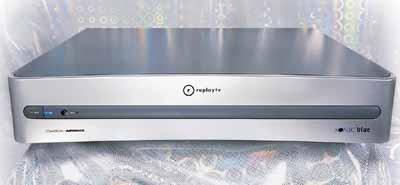
DIMENSIONS (WxHxD) 17 x 3 1/2 x 15 inches WEIGHT 12 pounds PRICE $300; plus $9.95 a month subscription or $250 one-time fee for the life of the unit MANUFACTURER SonicBlue, Dept. S&V, 2841 Mission College Blvd., Santa Clara, CA 95054; www.sonicblue.com; 877-737-5298 The success of any hard-disk video recorder is likely to turn as much on ease of use as on video quality. And given everything even a basic HDR has to handle, developing an effective user interface can be a tremendous challenge. After all, the job of the HDR goes way beyond the kind of simple time-shifting you do with your VCR. It has to be your video major domo-providing a menu of choices from all the broadcast, cable, and satellite sources you've connected to it; playing what you want, when you want it, however you want it (including pause, slow motion, commercial skip, instant replay, and other digital tricks); recording programs for later viewing, with easy ways to select what to save (by series title or lead actor, say, as well as date and time). And that's just scratching the surface. ReplayTV, now a brand of SonicBlue, has met this challenge handily with its latest model, the 5000. As if to underline how important its user interface is, the Model 5000 has no controls on its front panel other than an on/off switch. All operating control is done via the compact remote handset. Most ReplayTV 5000 functions depend on some sort of onscreen display. The primary graphic is the Guide grid, a program listing much like you'd see in the Sunday newspaper. You call up Channel Guide to see your broadcast/cable listings, or Replay Guide to see a grid of programs already recorded on the unit's hard drive. I was mightily impressed by the Model 5000's intuitive interface. To watch a broadcast/cable show you simply navigate the Channel Guide grid using the handset's cursor keys, then hit Select. Want to pause what you're watching? Press the Pause key, press it again (or Play) to resume, and press the Return to Live key to-d'oh!-return to "live" programming. Want to record a show? Cursor your way to its Channel Guide listing and press Record-done. (To record a show every week, you simply press Record twice.) Playing recorded programs works much the same way, but instead you use the Replay Guide, where the grid lists all the shows you've recorded. 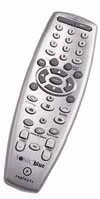 The Model 5000 depends largely on ReplayTV's Internet-based guide system, refreshing its listings overnight via either a dial-up or broadband connection-it has both telephone and RJ-45 Ethernet ports. (I used dial-up because I didn't have an Ethernet cable long enough to reach from my home theater setup to my cable modem and router.) This is a great system, but there's a catch: it ain't free. You'll need to subscribe to the guide service, which costs $9.95 a month, or you can pay a one-time fee of $250 for the life of the unit. Beyond a few minutes here and there fiddling with friends' HDRs, I hadn't spent much time with the breed, yet I was able to use many of the ReplayTV 5000's features without a hitch before so much as cracking open the manual. Pause, fast-scan forward and back, frame-advance, and more all fell readily to hand. The Model 5000 also has some powerful tools for finding content beyond merely browsing the grid. You can search for shows alphabetically (by title, description, actors, or director) or browse eight Replay Zones to view the channel guide distilled into subcategories such as Sports:Rodeo or Movies:Biography. There are nearly three dozen such categories just for movies, including subzones organized by star rating, by whether a film is letterboxed, and by ratings level (G, PG, PG-13, R, and X), and so on. Another nifty Model 5000 feature is Commercial Advance, which lets you skip commercials (and similar breaks) automatically. Yes, it works well, if not perfectly. You can't use Commercial Advance during the first couple of minutes of a program, and it fails to find the ads occasionally (SonicBlue says it's about 70% effective, though it seemed better than that to me). Most of the time when I came to a commercial during playback, I saw just 2 seconds or so before the Model 5000 magically jumped ahead to where the actual program resumed. This is powerful stuff-and it's the subject of great controversy (and even litigation) in the broadcasting world, none of which I'm going to rehash here. Let's just say I loved it. Of course, the ReplayTV 5000 also offers a full complement of video effects: multispeed, bidirectional fast-scan and slow motion (both were impressively clear and steady), Instant Replay (back 7 seconds), and Quick Skip (forward 30 seconds). It has two line inputs and outputs so it can record to and from a VCR, and it can be connected to a satellite receiver, integrating DirecTV or Dish Network programming into its guide. (It cannot, however, directly record satellite-delivered digital data as do HDR/satellite-receiver combos. First your satellite receiver has to decode the signal, then the ReplayTV encodes it again for recording, and finally decodes it for playback.) There's also a Photo Viewer that lets you store and recall JPEG-format images, which you can transfer from your Windows PC via the Model 5000's Ethernet port, after downloading an application from SonicBlue's Web site. But the big connectivity story here is that the same Ethernet port that lets you link the Model 5000 to the Web or a PC also lets you link it to a home network, allowing you to share programs among two or more Model 5000s. For example, if two are networked, you could use the bedroom HDR to watch the Patriots/Vikings game you recorded earlier on the living-room HDR, while recording another show on the living-room HDR. However, since only one Model 5000 was available during our review period, I wasn't able to check out the networking feature. (The Model 5000 also has a "future use" USB port so you can incorporate it in a wireless network.) Among the ReplayTV 5000's video outputs is a trio of component-video jacks that furnish a 480p (progressive-scan) output. This should auger well for video performance, and indeed, they worked fine with my Princeton widescreen HDTV, which will only sync up to 480p or higher video. However, while the Model 5000's video quality was fine for casual TV viewing, I found it disappointing even at the highest of its three record-quality options. "Live" video was even a touch grainy and pixelated, sort of like what you get on some DirecTV channels. Segments recorded at Standard quality (the lowest level) or Medium quality looked much the same, except in scenes with a lot of motion and busy backgrounds-in those cases, pixelation was more severe. The only other complaint I can cite is the hard drive's faintly audible, continuous hum. As I said, video was more than acceptable for everyday viewing, and with the ReplayTV 5000 so easy to use, I would cheerfully compromise video perfection to enjoy the user-friendly way it lets you find, save, time-shift, and replay programming. (And you gotta love any machine that makes it possible for Americans to watch more TV-right?) As this sort of super VCR-cum-TV server, the ReplayTV 5000 excels. RCA Scenium DRS7000N
The Model 5000 depends largely on ReplayTV's Internet-based guide system, refreshing its listings overnight via either a dial-up or broadband connection-it has both telephone and RJ-45 Ethernet ports. (I used dial-up because I didn't have an Ethernet cable long enough to reach from my home theater setup to my cable modem and router.) This is a great system, but there's a catch: it ain't free. You'll need to subscribe to the guide service, which costs $9.95 a month, or you can pay a one-time fee of $250 for the life of the unit. Beyond a few minutes here and there fiddling with friends' HDRs, I hadn't spent much time with the breed, yet I was able to use many of the ReplayTV 5000's features without a hitch before so much as cracking open the manual. Pause, fast-scan forward and back, frame-advance, and more all fell readily to hand. The Model 5000 also has some powerful tools for finding content beyond merely browsing the grid. You can search for shows alphabetically (by title, description, actors, or director) or browse eight Replay Zones to view the channel guide distilled into subcategories such as Sports:Rodeo or Movies:Biography. There are nearly three dozen such categories just for movies, including subzones organized by star rating, by whether a film is letterboxed, and by ratings level (G, PG, PG-13, R, and X), and so on. Another nifty Model 5000 feature is Commercial Advance, which lets you skip commercials (and similar breaks) automatically. Yes, it works well, if not perfectly. You can't use Commercial Advance during the first couple of minutes of a program, and it fails to find the ads occasionally (SonicBlue says it's about 70% effective, though it seemed better than that to me). Most of the time when I came to a commercial during playback, I saw just 2 seconds or so before the Model 5000 magically jumped ahead to where the actual program resumed. This is powerful stuff-and it's the subject of great controversy (and even litigation) in the broadcasting world, none of which I'm going to rehash here. Let's just say I loved it. Of course, the ReplayTV 5000 also offers a full complement of video effects: multispeed, bidirectional fast-scan and slow motion (both were impressively clear and steady), Instant Replay (back 7 seconds), and Quick Skip (forward 30 seconds). It has two line inputs and outputs so it can record to and from a VCR, and it can be connected to a satellite receiver, integrating DirecTV or Dish Network programming into its guide. (It cannot, however, directly record satellite-delivered digital data as do HDR/satellite-receiver combos. First your satellite receiver has to decode the signal, then the ReplayTV encodes it again for recording, and finally decodes it for playback.) There's also a Photo Viewer that lets you store and recall JPEG-format images, which you can transfer from your Windows PC via the Model 5000's Ethernet port, after downloading an application from SonicBlue's Web site. But the big connectivity story here is that the same Ethernet port that lets you link the Model 5000 to the Web or a PC also lets you link it to a home network, allowing you to share programs among two or more Model 5000s. For example, if two are networked, you could use the bedroom HDR to watch the Patriots/Vikings game you recorded earlier on the living-room HDR, while recording another show on the living-room HDR. However, since only one Model 5000 was available during our review period, I wasn't able to check out the networking feature. (The Model 5000 also has a "future use" USB port so you can incorporate it in a wireless network.) Among the ReplayTV 5000's video outputs is a trio of component-video jacks that furnish a 480p (progressive-scan) output. This should auger well for video performance, and indeed, they worked fine with my Princeton widescreen HDTV, which will only sync up to 480p or higher video. However, while the Model 5000's video quality was fine for casual TV viewing, I found it disappointing even at the highest of its three record-quality options. "Live" video was even a touch grainy and pixelated, sort of like what you get on some DirecTV channels. Segments recorded at Standard quality (the lowest level) or Medium quality looked much the same, except in scenes with a lot of motion and busy backgrounds-in those cases, pixelation was more severe. The only other complaint I can cite is the hard drive's faintly audible, continuous hum. As I said, video was more than acceptable for everyday viewing, and with the ReplayTV 5000 so easy to use, I would cheerfully compromise video perfection to enjoy the user-friendly way it lets you find, save, time-shift, and replay programming. (And you gotta love any machine that makes it possible for Americans to watch more TV-right?) As this sort of super VCR-cum-TV server, the ReplayTV 5000 excels. RCA Scenium DRS7000N 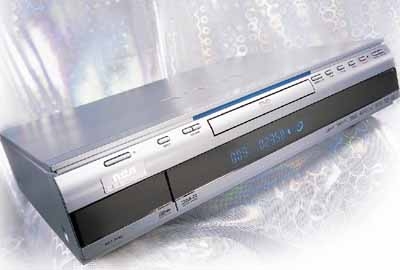
DIMENSIONS (WxHxD) 17 x 4 x 14 1/2 inches WEIGHT 13 pounds PRICE $599 MANUFACTURER Thomson, Dept. S&V, 10330 N. Meridian, Indianapolis, IN 46290; www.rca.com; 800-336-1900 Dig this: a typical hard-disk video recorder already has a lot of the necessary techno stuff for a perfectly good DVD player-MPEG-2 decoder (encoder, too, of course), video circuitry, Dolby Digital decoder (and encoder), on-screen display generators, and more. All that's missing is a disc transport and laser, so why not throw them in? Why not, indeed? RCA does exactly that with the Scenium DRS7000N Digital Media Recorder, combining an HDR with a progressive-scan DVD player. The HDR side of the RCA's personality is similar to the ReplayTV's: you can watch "live" TV programs with pause, scan, and slo-mo options, and you can record programs and play them back at your convenience. The DRS7000N also depends on an onscreen, grid-based channel guide, but the delivery system is different. Scenium uses Gemstar's GuidePlus+ technology, a no-fee directory that arrives piggybacked onto one of your local channels. Updates occur several times daily, though during my relatively brief trial, the guide put up only about two and a half days of full-info scheduling on most channels (ReplayTV's guide covered almost ten days). 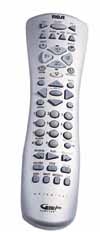 Navigation was straightforward using the remote control's cursor key set, abetted by the 1-2-3 keys (reminders of how to use these keys appear at the top of the guide screen). For example, to jump one day ahead in the grid, you cursor up to the guide's Listings tab and then press the 3 key. Similar keystrokes can tag a future program for recording or activate a timer that automatically turns on the DRS7000N and tunes in that show-kind of neat. Of course, you can record VCR-style as well by programming start/ end times and so on, or by manually starting and stopping. Another nifty feature is the small, live-action window in the upper-left corner of the guide screen that displays the currently tuned channel-I prefer this to having the full-screen image behind the grid, as with the ReplayTV 5000. But navigating and refreshing the DRS7000N's guide screens was slower than with the ReplayTV, and response to individual keystrokes was occasionally sluggish. (You can "lock" the video window so that it doesn't change each time you scroll to a new channel's gridline, which speeds things up a bit.) To find programming, the DRS7000N gives you three choices: browse the guide in its default full-listing format, sort programs alphabetically, or sort programs by genre. The alphabetical option gives you a simple list of show titles by the first letter you select-additional keystrokes are required to show the time and date, and then the description. The genre-sort routine provides about 16 subcategories in each of three realms-movies, sports, and children's. This narrows things down greatly but isn't as comprehensive as the ReplayTV categorization system. Additional GuidePlus+ features include text news updates, refreshed a few times daily, and promotional messages from Gemstar or others-yeah, ads. Happily, you don't have to cursor over any of these "tabs," so they're not really intrusive. The DRS7000N's DVD personality is very much like most any other player. Discs are handled just as in a "regular" player-because, of course, this is a regular player, with all the usual DVD and CD features. Track/chapter programming, repeat and shuffle play, DVD-Video zoom, menu displays and operations-they're all there. Like most DVD players today, the DRS7000N can also play MP3 files stored on CD. But very much unlike a conventional DVD player, it lets you copy those MP3 files to its hard drive for later playback. (MP3 copying is possible only one CD at a time.) Like the ReplayTV 5000, the DRS7000N will also display JPEG images, though these have to be on a CD since the RCA has no direct networking facilities. These files can also be copied to the hard drive for later recall. (The RCA also has a USB port on its front panel that can be used to transfer JPEG images or MP3 songs from a compatible MP3 player or flash-memory reader to the hard drive.) The DRS7000N's video performance was slightly better than the ReplayTV 5000's. The picture looked better at its "best" record quality: slightly softer and a touch oversaturated, but distinctly less pixelated in busy scenes. I could still see digital artifacts, but they were less intrusive than with the ReplayTV 5000, and the RCA did a better job with fast motion and pans across complex textures. Bottom line: The Scenium DRS7000N is a versatile combo. No, I'm not a big fan of its user interface or remote control, and I didn't find the GuidePlus+ system as powerful or as easy to use as ReplayTV's. Also, the hard drive produced the same continuous soft hum as the ReplayTV's. Nevertheless, the DRS7000N's performance as a video recorder is clearly first-rate. If you want a 21st-century VCR-equivalent-something you can use to time-shift tomorrow's ER or record Junkyard Wars every week-it won't let you down. And getting a capable DVD player in the bargain is, well, a bargain! Toshiba RD-X2
Navigation was straightforward using the remote control's cursor key set, abetted by the 1-2-3 keys (reminders of how to use these keys appear at the top of the guide screen). For example, to jump one day ahead in the grid, you cursor up to the guide's Listings tab and then press the 3 key. Similar keystrokes can tag a future program for recording or activate a timer that automatically turns on the DRS7000N and tunes in that show-kind of neat. Of course, you can record VCR-style as well by programming start/ end times and so on, or by manually starting and stopping. Another nifty feature is the small, live-action window in the upper-left corner of the guide screen that displays the currently tuned channel-I prefer this to having the full-screen image behind the grid, as with the ReplayTV 5000. But navigating and refreshing the DRS7000N's guide screens was slower than with the ReplayTV, and response to individual keystrokes was occasionally sluggish. (You can "lock" the video window so that it doesn't change each time you scroll to a new channel's gridline, which speeds things up a bit.) To find programming, the DRS7000N gives you three choices: browse the guide in its default full-listing format, sort programs alphabetically, or sort programs by genre. The alphabetical option gives you a simple list of show titles by the first letter you select-additional keystrokes are required to show the time and date, and then the description. The genre-sort routine provides about 16 subcategories in each of three realms-movies, sports, and children's. This narrows things down greatly but isn't as comprehensive as the ReplayTV categorization system. Additional GuidePlus+ features include text news updates, refreshed a few times daily, and promotional messages from Gemstar or others-yeah, ads. Happily, you don't have to cursor over any of these "tabs," so they're not really intrusive. The DRS7000N's DVD personality is very much like most any other player. Discs are handled just as in a "regular" player-because, of course, this is a regular player, with all the usual DVD and CD features. Track/chapter programming, repeat and shuffle play, DVD-Video zoom, menu displays and operations-they're all there. Like most DVD players today, the DRS7000N can also play MP3 files stored on CD. But very much unlike a conventional DVD player, it lets you copy those MP3 files to its hard drive for later playback. (MP3 copying is possible only one CD at a time.) Like the ReplayTV 5000, the DRS7000N will also display JPEG images, though these have to be on a CD since the RCA has no direct networking facilities. These files can also be copied to the hard drive for later recall. (The RCA also has a USB port on its front panel that can be used to transfer JPEG images or MP3 songs from a compatible MP3 player or flash-memory reader to the hard drive.) The DRS7000N's video performance was slightly better than the ReplayTV 5000's. The picture looked better at its "best" record quality: slightly softer and a touch oversaturated, but distinctly less pixelated in busy scenes. I could still see digital artifacts, but they were less intrusive than with the ReplayTV 5000, and the RCA did a better job with fast motion and pans across complex textures. Bottom line: The Scenium DRS7000N is a versatile combo. No, I'm not a big fan of its user interface or remote control, and I didn't find the GuidePlus+ system as powerful or as easy to use as ReplayTV's. Also, the hard drive produced the same continuous soft hum as the ReplayTV's. Nevertheless, the DRS7000N's performance as a video recorder is clearly first-rate. If you want a 21st-century VCR-equivalent-something you can use to time-shift tomorrow's ER or record Junkyard Wars every week-it won't let you down. And getting a capable DVD player in the bargain is, well, a bargain! Toshiba RD-X2 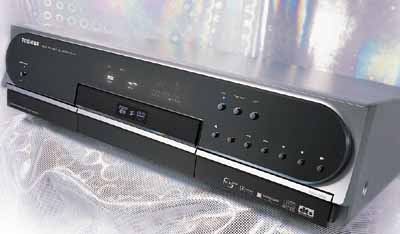 DIMENSIONS (WxHxD) 17 x 4 3/8 x 13 1/2 inches WEIGHT 14 pounds PRICE $1,500 MANUFACTURER Toshiba America, Dept. S&V, 82 Totowa Rd., Wayne, NJ 07470; www.toshiba.com/tacp; 800-631-3811 Once you've combined a DVD player and a hard-disk recorder, what's the next logical step? Make it a hard-disk/DVD recorder like Toshiba's RD-X2. It combines DVD playback and recording along with an onboard hard drive for storing content you plan to dub to DVD, as well as for recording TV programs. The RD-X2 is laid out much like a VCR, with conventional transport and record keys on both its glossy front panel and remote control. There's no onscreen grid programming guide, or any other automated program-finding system. Your options for recording broadcast or cable TV are to enter start/stop times, dates, and so on the old-fashioned way-manually-or to use the VCR Plus+ system. You've probably used VCR Plus+ with a VCR, and it works the same way here: look up the program in TV Guide or your local paper, find its six- or seven-digit code, and key the code into the Toshiba's VCR Plus+ screen. Oh, yeah-first you have to set up your RD-X2 according to the cable-conversion chart from your newspaper's TV listings, so that what you think is on Channel 47 and what the Toshiba thinks is on it agree. On the other hand, VCR Plus+ is subscription-free and requires no network or phone connection.
DIMENSIONS (WxHxD) 17 x 4 3/8 x 13 1/2 inches WEIGHT 14 pounds PRICE $1,500 MANUFACTURER Toshiba America, Dept. S&V, 82 Totowa Rd., Wayne, NJ 07470; www.toshiba.com/tacp; 800-631-3811 Once you've combined a DVD player and a hard-disk recorder, what's the next logical step? Make it a hard-disk/DVD recorder like Toshiba's RD-X2. It combines DVD playback and recording along with an onboard hard drive for storing content you plan to dub to DVD, as well as for recording TV programs. The RD-X2 is laid out much like a VCR, with conventional transport and record keys on both its glossy front panel and remote control. There's no onscreen grid programming guide, or any other automated program-finding system. Your options for recording broadcast or cable TV are to enter start/stop times, dates, and so on the old-fashioned way-manually-or to use the VCR Plus+ system. You've probably used VCR Plus+ with a VCR, and it works the same way here: look up the program in TV Guide or your local paper, find its six- or seven-digit code, and key the code into the Toshiba's VCR Plus+ screen. Oh, yeah-first you have to set up your RD-X2 according to the cable-conversion chart from your newspaper's TV listings, so that what you think is on Channel 47 and what the Toshiba thinks is on it agree. On the other hand, VCR Plus+ is subscription-free and requires no network or phone connection. 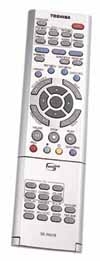 The RD-X2 is the most complex of these three components, and DVD recording is by nature not a simple procedure. But while its complexity yields great versatility on the DVD side, as an HDR the Toshiba's functionality is the most limited in this trio because it lacks a program guide and one-button programming. To watch TV, you select a channel as you would on a VCR, by entering the number or surfing with the up/down keys. In either case, you're watching real-time broadcasts that aren't being copied or buffered to the hard drive (see "Hard-Disk Recorder Basics"). If you then hit the Timeslip button on the remote, a "Preparing TV Pause Mode" alert comes onscreen, and after about 10 seconds the picture freezes. Press Play to resume watching. But now, since you're watching video streaming from the hard disk, you can pause "live" TV and use the Instant Replay and Instant Skip keys to jump back or forward. You can also use the bidirectional Picture Search and Slow buttons for fast-search and slow-motion effects. As long as you stay in the Timeslip mode, the video streaming through the RD-X2 is saved temporarily to the hard drive. When you press Stop, another alert asks if you want to keep the previously saved segment "permanently." As a DVD recorder, the RD-X2 uses the rewritable DVD-RAM and the write-once DVD-R formats. Each time you schedule or begin a recording, you can choose to save it to the hard drive or to a DVD-RAM disc. (Toshiba recommends cartridge-protected 4.7-gigabyte DVD-RAMs, which run $10 to 15 apiece.) Recording to DVD is more or less transparent: you program and proceed pretty much as you would with hard-drive recording. Selecting the Relay mode causes any additional data to spill over onto the hard drive when the DVD fills up (assuming free space exists on the drive). You can then go back and free up some space on the DVD (by deleting less important segments or long commercial breaks), then dub the spillover back onto the DVD. You can also dub material from the hard drive to a DVD-RAM-either a direct, bit-for-bit copy (at up to about 4x normal speed) or at a lower bit rate, trading off image quality to conserve space. Recording to a DVD-R is a one-shot dub: You can only dub from the hard drive to a virgin DVD-R by copying a whole disc's worth of data in one go rather than in multiple sessions. And of course you can't erase anything already recorded. Toshiba offers dozens of additional recording variations-far too many to discuss here. Most notable is the wide selection of video and audio bit rates. For video, the default rates are LP, or 2.2 megabits per second (Mbps), which is equivalent to about 4 hours of recording time on a DVD-RAM, and SP (4.6 Mbps), equivalent to 2 hours. But you can also select Manual and dial in a bit rate anywhere from 9.2 to 1.4 Mbps, in 0.2-Mbps increments, to get from 1 to 6 hours of recording time. Then you select one of two audio bit rates for Dolby Digital; linear-PCM (CD-type) audio is also available for certain bit-rate settings. The RD-X2's recorded video quality was very good-equal to the RCA and the ReplayTV in its SP mode, and even a little better at its maximum-quality (1-hour) setting. The Toshiba's hard drive hummed softly but audibly, just like the ones in the RCA and ReplayTV, but it did so only while powered up, not continuously. The RD-X2 probably isn't a product for the technophobe, but if you're prepared to scale its steep learning curve, you'll get an awful lot of A/V recording choices. Its HDR features are basic, but its storage capacity is infinitely expandable-just buy more DVD-RAMs. More important is that it gives you the ability to "pre-master" DVD recordings by editing and assembling shows or segments on the hard disk before dubbing them to DVD-R discs (playable on virtually any DVD machine). That alone should thrill videophile collectors-or anyone with a library of aging home-made VHS or camcorder tapes begging for digital archiving. These products from ReplayTV, RCA, and Toshiba are different enough from each other to show that the emerging category of "hard-disk video recorder" offers a number of intriguing home-entertainment possibilities. My feeling is that the newer and more powerful the technology, the more important simplicity becomes. The ReplayTV 5000 has this base covered-it's the easiest of these components to learn and use, but it also has the narrowest range of capabilities. The Toshiba is the most complex (and expensive) component here, which also means it's the most difficult to use. You'll need to spend some time with it to get a complete read on its many features. The transition from tape-based (VCR) to digital recording is only just beginning, but the RD-X2 makes a strong start. Being able to archive high-quality A/V programming in optical-disc form is powerfully attractive on its own, but the Toshiba delivers much more: editing capabilities, library management, and hard-disk control over your TV viewing-plus full DVD-player functionality. RCA's Scenium DRS7000N splits the difference, with a reasonably priced combo that should appeal to a wide range of shoppers: "Buy a DVD player-get an HDR!" (Or vice versa.) Hard-drive-based home theater components have arrived. Most of us have already long since taken digital video playback-whether via DVD, satellite, or cable-for granted. How long can it be before digital video recording, time-shifting, and storage are equally commonplace? Not very long at all, if these new-generation products are any indication. Features and Specs (PDF)
The RD-X2 is the most complex of these three components, and DVD recording is by nature not a simple procedure. But while its complexity yields great versatility on the DVD side, as an HDR the Toshiba's functionality is the most limited in this trio because it lacks a program guide and one-button programming. To watch TV, you select a channel as you would on a VCR, by entering the number or surfing with the up/down keys. In either case, you're watching real-time broadcasts that aren't being copied or buffered to the hard drive (see "Hard-Disk Recorder Basics"). If you then hit the Timeslip button on the remote, a "Preparing TV Pause Mode" alert comes onscreen, and after about 10 seconds the picture freezes. Press Play to resume watching. But now, since you're watching video streaming from the hard disk, you can pause "live" TV and use the Instant Replay and Instant Skip keys to jump back or forward. You can also use the bidirectional Picture Search and Slow buttons for fast-search and slow-motion effects. As long as you stay in the Timeslip mode, the video streaming through the RD-X2 is saved temporarily to the hard drive. When you press Stop, another alert asks if you want to keep the previously saved segment "permanently." As a DVD recorder, the RD-X2 uses the rewritable DVD-RAM and the write-once DVD-R formats. Each time you schedule or begin a recording, you can choose to save it to the hard drive or to a DVD-RAM disc. (Toshiba recommends cartridge-protected 4.7-gigabyte DVD-RAMs, which run $10 to 15 apiece.) Recording to DVD is more or less transparent: you program and proceed pretty much as you would with hard-drive recording. Selecting the Relay mode causes any additional data to spill over onto the hard drive when the DVD fills up (assuming free space exists on the drive). You can then go back and free up some space on the DVD (by deleting less important segments or long commercial breaks), then dub the spillover back onto the DVD. You can also dub material from the hard drive to a DVD-RAM-either a direct, bit-for-bit copy (at up to about 4x normal speed) or at a lower bit rate, trading off image quality to conserve space. Recording to a DVD-R is a one-shot dub: You can only dub from the hard drive to a virgin DVD-R by copying a whole disc's worth of data in one go rather than in multiple sessions. And of course you can't erase anything already recorded. Toshiba offers dozens of additional recording variations-far too many to discuss here. Most notable is the wide selection of video and audio bit rates. For video, the default rates are LP, or 2.2 megabits per second (Mbps), which is equivalent to about 4 hours of recording time on a DVD-RAM, and SP (4.6 Mbps), equivalent to 2 hours. But you can also select Manual and dial in a bit rate anywhere from 9.2 to 1.4 Mbps, in 0.2-Mbps increments, to get from 1 to 6 hours of recording time. Then you select one of two audio bit rates for Dolby Digital; linear-PCM (CD-type) audio is also available for certain bit-rate settings. The RD-X2's recorded video quality was very good-equal to the RCA and the ReplayTV in its SP mode, and even a little better at its maximum-quality (1-hour) setting. The Toshiba's hard drive hummed softly but audibly, just like the ones in the RCA and ReplayTV, but it did so only while powered up, not continuously. The RD-X2 probably isn't a product for the technophobe, but if you're prepared to scale its steep learning curve, you'll get an awful lot of A/V recording choices. Its HDR features are basic, but its storage capacity is infinitely expandable-just buy more DVD-RAMs. More important is that it gives you the ability to "pre-master" DVD recordings by editing and assembling shows or segments on the hard disk before dubbing them to DVD-R discs (playable on virtually any DVD machine). That alone should thrill videophile collectors-or anyone with a library of aging home-made VHS or camcorder tapes begging for digital archiving. These products from ReplayTV, RCA, and Toshiba are different enough from each other to show that the emerging category of "hard-disk video recorder" offers a number of intriguing home-entertainment possibilities. My feeling is that the newer and more powerful the technology, the more important simplicity becomes. The ReplayTV 5000 has this base covered-it's the easiest of these components to learn and use, but it also has the narrowest range of capabilities. The Toshiba is the most complex (and expensive) component here, which also means it's the most difficult to use. You'll need to spend some time with it to get a complete read on its many features. The transition from tape-based (VCR) to digital recording is only just beginning, but the RD-X2 makes a strong start. Being able to archive high-quality A/V programming in optical-disc form is powerfully attractive on its own, but the Toshiba delivers much more: editing capabilities, library management, and hard-disk control over your TV viewing-plus full DVD-player functionality. RCA's Scenium DRS7000N splits the difference, with a reasonably priced combo that should appeal to a wide range of shoppers: "Buy a DVD player-get an HDR!" (Or vice versa.) Hard-drive-based home theater components have arrived. Most of us have already long since taken digital video playback-whether via DVD, satellite, or cable-for granted. How long can it be before digital video recording, time-shifting, and storage are equally commonplace? Not very long at all, if these new-generation products are any indication. Features and Specs (PDF)























































